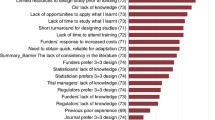ABSTRACT
Dose–response analysis is one of the accepted efficacy endpoints to establish effectiveness. The purpose of this research was to inform selection of an appropriate pre-specified primary dose–response analysis to demonstrate drug efficacy in a registration trial. The power and the type I error rate of the placebo-corrected (i.e., simply adjusting the observed treatment value by subtracting the placebo mean) and the placebo-anchored (i.e., including the placebo data as dose 0 in the regression) slope analyses were assessed based on regulatory submission data for two antihypertensive drugs and simulated data from hypothetical clinical trials. In the simulated hypothetical trials, the impact of different dosing strategies (i.e., the fixed dose versus the weight-based per kilogram dose), sample size, and scenarios governing the drug exposure–response relationship (e.g., E max, ED 50 , and SD) was also evaluated. For each scenario, a total 300 replications were simulated. The placebo-anchored slope analysis is always more powerful to demonstrate effectiveness in all plausible scenarios. The difference between the placebo-anchored and the placebo-corrected analyses was maximum when the studied doses were too high. However, the dose–response analysis is not sensitive to the dosing strategies. Furthermore, the type I error rate of these two methods was also found to be comparable. The design of dose–response studies should carefully consider these results to justify the inclusion of placebo and the analysis method. The pharmaceutical industry and the regulatory agencies are equally responsible for using the appropriate methods of primary analysis and providing justification in the protocol.




Similar content being viewed by others
References
Guideline for industry: dose–response information to support drug registration, ICH-E41994: [(http://www.fda.gov/downloads/Drugs/GuidanceComplianceRegulatoryInformation/Guidances/ucm073115.pdf) p.].
Guidance for industry providing clinical evidence of effectiveness for human drug and biological products: [(http://www.fda.gov/downloads/Drugs/GuidanceComplianceRegulatoryinformation/Guidances/ucm078749.pdf) p.].
Candesartan clinical pharmacology review 2009: [(http://www.fda.gov/downloads/Drugs/DevelopmentApprovalProcess/DevelopmentResources/UCM189128.pdf) p.].
Metoprolol clinical pharmacology review summary 2006: [(http://www.fda.gov/downloads/Drugs/DevelopmentApprovalProcess/DevelopmentResources/UCM164065.pdf) p.].
Olmesartan clinical pharmacology review 2010: [(http://www.fda.gov/downloads/Drugs/DevelopmentApprovalProcess/DevelopmentResources/UCM201697.pdf) p.].
Valsartan clinical pharmacology review 2007: [(http://www.fda.gov/downloads/Drugs/DevelopmentApprovalProcess/DevelopmentResources/ucm072894.pdf) p.].
Oxcarbazepine approval package: [(http://www.accessdata.fda.gov/drugsatfda_docs/nda/99/21-014_Trileptal.cfm) pp.].
Rufinamide approval package: [(http://www.accessdata.fda.gov/drugsatfda_docs/nda/2008/021911s000_TOC.cfm) p.].
Lee JY, Garnett CE, Gobburu JV, Bhattaram VA, Brar S, Earp JC, et al. Impact of pharmacometric analyses on new drug approval and labelling decisions: a review of 198 submissions between 2000 and 2008. Clin Pharmacokinet. 2011;50(10):627–35.
Benjamin DK, Smith PB, Jadhav P, Gobburu JV, Murphy MD, Hasselblad V, et al. Pediatric antihypertensive trial failures: analysis of end points and dose range. Hypertension. 2008;51(4):834–40.
Li JS, Cohen-Wolkowiez M, Pasquali SK. Pediatric cardiovascular drug trials, lessons learned. J Cardiovasc Pharmacol. 2011;58(1):4–8.
2000 CDC growth charts for the United States: methods and development: [(http://www.cdc.gov/nchs/data/series/sr_11/sr_246.pdf) p.].
Guidance for industry: exposure–response relationships—study design, data analysis, and regulatory applications 2003: [(http://www.fda.gov/downloads/Drugs/GuidanceComplianceRegulatoryInformation/Guidances/ucm072109.pdf) p.].
Disclaimer
The contents of the manuscript represent the authors’ personal opinion and do not necessarily reflect any position of the Food and Drug Administration.
Financial Support
None
Conflict of Interest
None
Author information
Authors and Affiliations
Corresponding author
Rights and permissions
About this article
Cite this article
Liu, J., Jadhav, P., Wang, Y. et al. Improper Selection of a Pre-specified Primary Dose–Response Analysis Delays Regulatory Drug Approval. AAPS J 15, 407–414 (2013). https://doi.org/10.1208/s12248-012-9438-2
Received:
Accepted:
Published:
Issue Date:
DOI: https://doi.org/10.1208/s12248-012-9438-2




